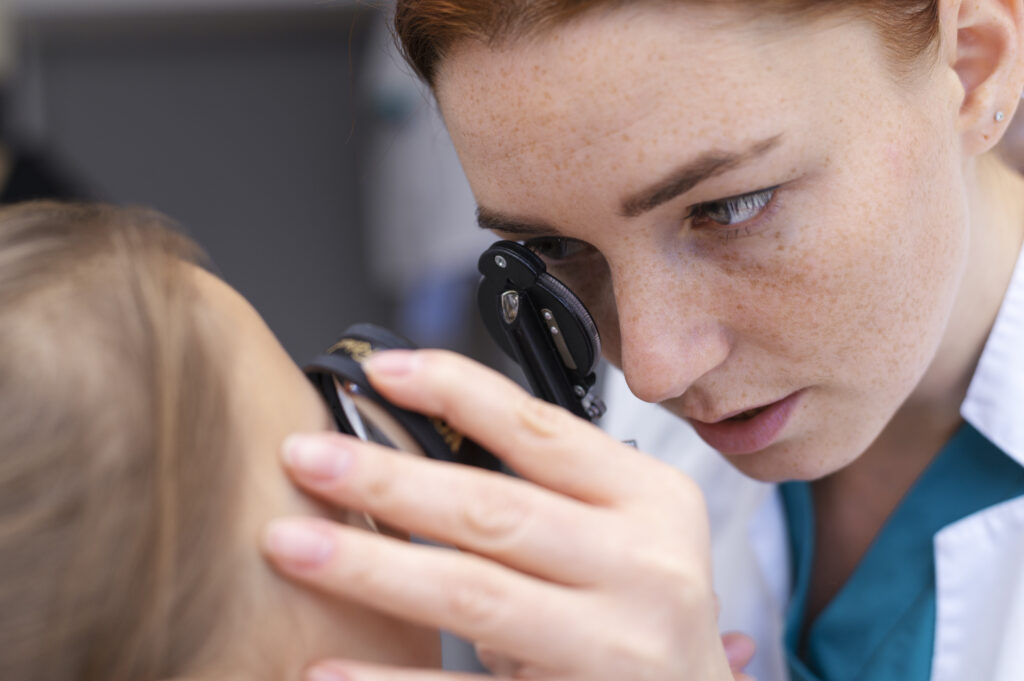The most severe risk is the vision loss attributed to diabetic retinopathy, which has been associated with so many challenges with diabetes. While most individuals know that controlling this condition requires management of blood sugar, the effectiveness of diabetic retinopathy fundoscopy in preventing vision loss is unknown to most people.
In this blog, I will take you through what diabetic retinopathy is, how fundoscopy works, and why regular eye exams are so crucial in those at risk. This guide will ensure that you understand everything you need to know about diabetic retinopathy fundoscopy and how it plays a pivotal role in preserving your vision.

What Is Diabetic Retinopathy?
Diabetic retinopathy happens to be a complication of diabetes that affects blood vessels in your retina. Your retina is that part of your eye that sees light and sends images to your brain. High blood sugars make these blood vessels weaken, swell, or even leak, damaging the retina. Over time, this type of damage will lead to vision impairment, or worse, blindness.
Stages of Diabetic Retinopathy
This stage of diabetic retinopathy needs to be understood to know how serious the condition could be:
- Mild Non-Proliferative Retinopathy: Early stage wherein tiny areas of blood vessels in the retina start to weaken.
- Moderate Non-Proliferative Retinopathy: This is a progression wherein blood vessel swelling can interfere with the passage of blood through the retina.
- Severe Non-Proliferative Retinopathy: In which many blood vessels have become blocked and the retina responds by producing new but abnormal vessels.
- Proliferative Retinopathy: It is the most advanced stage in which there is a proliferation of new blood vessels in the retina, which often tends to cause severe loss of vision.
Now that you know how diabetic retinopathy progresses, it’s time for you to know how to prevent vision loss using diabetic retinopathy fundoscopy.
What Is Fundoscopy?
A fundoscopy is a routine eye examination by which a healthcare worker is able to view the rear part of the eye specifically the retina, as well as the blood vessels at the back of the eye. This exam is performed using an ophthalmoscope specialized instrument used for viewing the interior of the eye-observing the elements such as the optic disc or retinal blood vessels.
This examination is particularly crucial for diabetic patients since it can detect early signs of diabetic retinopathy. Regular diabetic retinopathy fundoscopy allows doctors to monitor changes in the eye’s retinal health, providing an early warning system that could eventually prevent the loss of vision.
The Role of Diabetic Retinopathy Fundoscopy in Early Detection
Diabetic retinopathy fundoscopy is one of the most apparent benefits – it can often diagnose damage to the retina even before the symptoms develop. Such vision loss, resulting from diabetic retinopathy, often manifests silently without any palpable warning signs in the first stages. Vision difficulties may appear when damage is at a very serious point.
Why Early Detection Matters
It is very important to treat diabetic retinopathy early. If you receive an early diagnosis of its initial stages, diabetic retinopathy can be handled with a variety of medical interventions and laser treatments designed to regulate abnormal blood vessel growth. This should put a stopper or retard the development of the disease and save your vision in the long term.
Diabetic retinopathy fundoscopy can sense even the most minute changes on your retina, which may be the early stages of diabetic retinopathy. You may, therefore be able to prevent the very risk against your vision if this condition is checked as early as possible.
How Diabetic Retinopathy Fundoscopy Can Prevent Vision Loss
Regular diabetic retinopathy fundoscopy may be what saves a person’s sight or loses it completely. Here are the most critical ways that this exam can save your vision:
Checking on the Progression of Retinopathy
This helps doctors in monitoring the progression of disease for diagnosed diabetic retinopathy patients. Through regular checks, they can now consider whether the patient’s condition is stable or worsening. This may help them to make the appropriate decisions about whether and when to intervene, thereby stopping further damage to the retina.
Early Treatment Options Enabled
If diabetic retinopathy is diagnosed early by diabetic retinopathy fundoscopy, then treatment can be started on the condition before much damage is done. Because of this reason, the treatment of diabetic retinopathy may also vary from person to person depending on the severity; for instance, treatments offered may include:
- Laser treatment: This may be done to seal off leaking blood vessels in the retina so that no further damage will be done.
- Anti-VEGF injections: These injections will ensure that there is no abnormal growth of blood vessels in the retina.
Surgical procedures: Vitrectomy; In advanced cases, surgical intervention might be considered to remove the blood or scar tissue that may collect on the retina.
Preventive Lifestyle Changes
Besides medical treatment, a diabetic retinopathy fundoscopy may signify the time when a lifestyle has to be amended. For example, maintaining sugar levels within control, ensuring the management of blood pressure, and adopting healthy diets can slow the progression of retinopathy. The regular fundoscopy examination is a wake-up call where proactive health management is vital for the protection of your vision.
Who Should Get a Diabetic Retinopathy Fundoscopy?
You may not be required to have a fundoscopy, however, if you are diabetic this is an essential procedure for maintaining the health of your eyes. Regardless of whether you suffer from Type 1 diabetes or Type 2 diabetes, it is recommended that you incorporate regular medical exams with fundoscopy as part of your management plan.
How Often is Too Often?:
The frequency of fundoscopy for diabetic retinopathy is determined by the duration of diabetes and blood sugar control. Generally, the following guidelines apply:
- Type 1 Diabetes: Exams every year should begin five years after the diagnosis.
- Type 2 Diabetes: Exams every year should be started right away upon diagnosis.
- High-risk patients: More frequent exams might be necessary if you have poorly controlled diabetes or high blood pressure.
What to Look for in a Fundoscopy Test
Most patients would like to know what happens in the process of undertaking a fundoscopy test. The process is usually painless, with minimal discomfort, and relatively short. The following is a step-by-step guide.
- Dilation: Patients receiving a dilated examination will receive eye drops that widen their pupils. The dilation enables an unobstructed view of the back of the eye.
- Exam: The doctor will use the ophthalmoscope to view inside the retina and optic nerve for any appearance of damage or abnormal blood vessels in this examination.
- Follow-up: Depending on the outcome, the doctor may need to recommend further tests, lifestyle changes, or treatments.
You will have blurred vision from the eye drops after the exam, so you may like to bring along some sunglasses to protect your eyes from light.
Treatment Options After Fundoscopy
In most cases of diabetic retinopathy, if it is discovered during a fundoscopy exam, treatment can be given. Early stages of diabetic retinopathy do not require much in the form of treatment other than regular check-ups and better management of blood sugar levels. Advanced cases may call for several treatments that your eye doctor can prescribe:
Prevention of Diabetic Retinopathy
Proper diabetes management is the best way to prevent diabetic retinopathy. Blood sugar levels control, healthy blood pressure, and well-managed cholesterol prevent a major risk of retinal damage. Retinal fundoscopy as part of diabetic retinopathy exams is one of the many contributions towards early detection and prevention, ensuring that any potential problems occur before you ever know that they are there and affect your vision.
Conclusion
It detects early signs of retinal damage and thereby allows for timely treatment, which may prevent more complications from arising. In conclusion, diabetic retinopathy fundoscopy is one of the essential tools to be enlisted in the fight against vision loss among diabetics. Combined with good diabetes management and lifestyle changes, regular fundoscopy examinations can do the best to preserve one’s vision and protect eye health.
If you have diabetes, do not wait for the vision problem to set in. Schedule a fundoscopy exam today and take the first step toward protecting your sight for the future.










